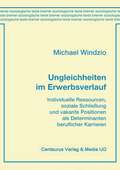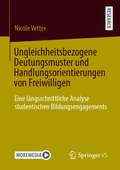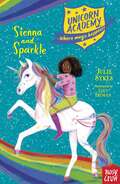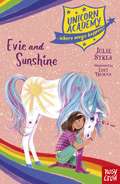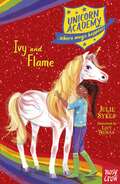- Table View
- List View
Ungifted: Intelligence Redefined
by Scott Barry Kaufman"A convincing -- and moving -- case for the great potential of even an 'ordinary' mind." --ParadeIn Ungifted, cognitive psychologist Scott Barry Kaufman -- who was relegated to special education as a child -- offers a new way of looking at intelligence. He explores the latest research in genetics, neuroscience, and psychology to challenge the conventional wisdom about the childhood predictors of adult success, arguing for a more holistic approach to intelligence that takes into account each individual's abilities, engagement, and personal goals.Combining original research and a singular compassion, Ungifted increases our appreciation for all different kinds of minds and ways of achieving both personally meaningful and publicly recognized forms of success.
Ungleiche Netzwerke - Vernetzte Ungleichheit: Persönliche Beziehungen im Kontext von Bildung und Status (Netzwerkforschung)
by Jan MewesBei dem vorliegenden Text handelt es sich um eine leicht überarbeitete Version meiner Dissertation, die im Mai 2009 an der Universität Bremen angenommen wurde. Die Arbeit entstand im Rahmen meiner Beschäftigung im Forschun- projekt „Transnationalisierung sozialer Beziehungen“, welches von 2005 bis 2008 von der Deutschen Forschungsgemeinschaft (DFG) gefördert wurde. Ohne die Hilfe vieler Menschen wäre die Fertigstellung dieser Arbeit nicht möglich gewesen. Ich bin zu großem Dank verpflichtet: Steffen Mau für die langjährige Unterstützung und die konstruktive Kritik; Johannes Huinink für die hilfreichen Kommentare und das stets offene Ohr; der DGS-Arbeitsgruppe ‚Netzwerkforschung’ für die theoretischen und praktischen Impulse; Roger Häußling und Christian Stegbauer für ihr Interesse, meine Arbeit in die VS- Reihe ‚Netzwerkforschung’ aufzunehmen; den EDV-Verantwortlichen Hartmut Asendorf, Markus Miezal und Jakob Lenfers, die dafür gesorgt haben dass mein Computer innerhalb von vier Jahren immer tadellos lief; den studentischen Kräften Lena Laube, Niels Winkler, Franziska Klöfkorn, Melanie Heußner, Katharina Poschmann und Maike Schulz für ihre Unterstützung bei unzähligen Recherchen und Analysen (besonders Maike gilt ein besonderes Dankeschön für das umsichtige Lektorat meiner Dissertation und die Auseinandersetzung mit den Formatvorlagen); Patrick, Christoph, Sebastian, Sina, Lena, Nadya, Herwig, Oliver, Charlotte und vielen weiteren Fellows für eine Vielzahl geselliger und lustiger Stunden; noch einmal Patrick für die kritische und aufmerksame Dur- sicht meiner Manuskripte; dem gesamten BIGSSS-Team für eine angenehme Arbeitsatmosphäre, dem ‚Runken-Eck’ für die Aufhellung meiner Laune in regnerischen Stunden; der Kirchweg-Crew um Jens, Kirsten, Anja und Melanie für die schöne Zeit in unserer WG sowie Thomas und Manuel, deren langjährige
Ungleichheiten im Erwerbsverlauf: Individuelle Ressourcen, soziale Schließung und vakante Positionen als Determinanten beruflicher Karrieren (Bremer soziologische Texte)
by Michael WindzioIn der Sekundäranalyse von Lebensverlaufsdaten versucht der Autor nachzuweisen, daß berufliche Verläufe von strukturellen Kontextbedingungen geprägt sind und folglich nicht allein aus den Investitionen in die individuellen Bildungsressourcen resultieren. Aus der allgemeinen ungleichstheoretischen Diskussion werden drei Strukturierungsmechanismen sozialer Ungleichheit hergeleitet, von denen jeder selbst wiederum durch spezielle theoretische Ansätze fundiert ist: Individuelle Ressourcen, soziale Schließung und vakante Positionen. Die Ereignisananalyse von Daten aus der Bundesrepublik Deutschland der historischen Periode von 1950 bis 1988 hat ergeben, daß sich sowohl der berufsstrukturelle Wandel zur Dienstleistungsgesellschaft als auch die altersdemographische Verteilung als Einflußfaktoren auf die Verfügbarkeit vakanter Positionen auswirkten. Gezeigt wird darüber hinaus, wie der Zugang zu attraktiven Positionen durch bestimmte Praktiken der sozialen Schließung eingeschränkt wird. Der Autor, geb.1970, studierte Soziologie und Politische Wissenschaft in Heidelberg. Er ist derzeit als wissenschaftlicher Mitarbeiter an der Universität Bremen am Sonderforschungsbereich 186 'Statuspassagen und Risikolagen im Lebensverlauf' tätig und arbeitet an einer Dissertation über den Zusammenhang von Institutionenwandel, Organisationsökologie und Arbeitmarktmobilität.
Ungleichheitsbezogene Deutungsmuster und Handlungsorientierungen von Freiwilligen: Eine längsschnittliche Analyse studentischen Bildungsengagements
by Nicole VetterDas Buch beleuchtet das in Deutschland noch relativ junge Feld zivilgesellschaftlichen Bildungsengagements aus ungleichheitssoziologischer Perspektive anhand eines konkreten Falls: Ein studentischer Verein, der ‚motivierten‘ und gleichzeitig ‚sozial benachteiligten‘ Schüler*innen der Sekundarstufe I kostenfreie Nachhilfe in den Kernfächern an Schulen in einem großstädtischen Raum ermöglicht. Die Studie rekonstruiert, welche Wahrnehmungen sozialer Ungleichheit engagierte Studierende bezüglich ihres auf den Abbau von (Bildungs-)Benachteiligung gerichteten Handelns besitzen und wie diese die ehrenamtliche Handlungsorientierung strukturieren.
Ungleichheitssensible Hochschullehre: Positionen, Voraussetzungen, Perspektiven
by Kathrin RheinländerDie BeitragsautorInnen des vorliegenden Bandes diskutieren das forschungsprogrammatische Konzept einer ungleichheitssensiblen Hochschullehre aus unterschiedlichen Perspektiven. Ziel ist es, in systematischer Weise aufzuzeigen, wie sich Ungleichheitssensibilität in der Lehre verankern lässt, mit welchen Widerständen zu rechnen ist und welche professionellen Praxen von Lehrenden im Kontext ungleichheitssensibler Hochschullehre entscheidend sein können. Denn wenngleich an den Hochschulen darüber viel diskutiert wird, gibt es wenig empirische Hinweise dazu, welche Lehrkultur für eine heterogenitätsorientierte und ungleichheitssensible Lehre in der Praxis grundlegend ist, welche Werte und Überzeugungen bei Hochschullehrenden zu erwarten sind und welche pädagogischen Handlungen und tradierten Normalitätsverständnisse der Lehrenden bei der Festschreibung von Homogenitäten, von Differenzen und der Konstruktion von Ungleichheiten eine Rolle spielen.
Unhomework: How To Get The Most Out Of Homework Without Really Setting It (PDF)
by Mark CreasyIn a dynamic and ever changing education climate it is important to re-evaluate practice in schools on a regular basis in order to ensure that we are doing the right thing for our children. With questions being raised over the value of homework, Mark Creasy advises teachers and parents on how to get the most out of homework without letting it get in the way of their lives. This book questions the necessity of homework while recognising that most teachers have a statutory duty to provide it. The author provides suggestions for how teachers can make homework more effective, applicable and less pointless; organising classroom learning to allow children to set their own homework and creating opportunities for learning out of everyday situations. Founded on over 10 years of Mark's real teaching practice in both primary and secondary schools, Unhomework is entertaining as well as informative, being underpinned by personal anecdotes from his teaching career. It challenges the current status quo of traditionally set homework and provides an insight for parents and educators about how homework can be done differently, for greater effect as an extension to classroom practice. Unhomework is based on the 5Rs and these are detailed for teachers to implement to secure Unhomework successfully. With practical ideas for teachers across year groups and subjects to use Unhomework is for teachers (Year 3-13) at all stages of the profession, senior managers in primary and secondary phases, independent and state sectors, parents, teacher trainers.
Unhomework: How to get the most out of homework without really setting it
by Mark CreasyIn a dynamic and ever changing education climate it is important to re-evaluate practice in schools on a regular basis in order to ensure that we are doing the right thing for our children. With questions being raised over the value of homework, Mark Creasy advises teachers and parents on how to get the most out of homework without letting it get in the way of their lives. This book questions the necessity of homework while recognising that most teachers have a statutory duty to provide it. The author provides suggestions for how teachers can make homework more effective, applicable and less pointless; organising classroom learning to allow children to set their own homework and creating opportunities for learning out of everyday situations.
Unhooking from Whiteness: Resisting the Esprit de Corps (Constructing Knowledge: Curriculum Studies in Action)
by Nicholas D. Hartlep Cleveland Hayes"What happens to people when they choose to unhook from the rules and modes of thought whiteness requires and expects of them?Whiteness promotes a form of hegemonic thinking, which influences not only thought processes but also behavior within the academy. Working to dismantle the racism and whiteness that continue to keep oppressed people powerless and immobilized in academe requires sharing power, opportunity, and access. Removing barriers to the knowledge created in higher education is an essential part of this process. The process of unhooking oneself from institutionalized whiteness certainly requires fighting hegemonic modes of thought and patriarchal views that persistently keep marginalized groups of academics in their station (or at their institution). In the explosive Unhooking from Whiteness: Resisting the Esprit de Corps, editors Hartlep and Hayes continue the conversation they began in 2013; they and the chapter contributors are brave enough to tell a contemporary reality few are brave enough to discuss. “In this groundbreaking and revolutionary sequel volume to Unhooking from Whiteness: The Key to Dismantling Racism in the United States, Nicholas Hartlep and Cleveland Hayes and a group of fearless scholars-activists continue to manifest liberative counternarratives, counteraccounts, personal memoirs, poetry, and testimonios of ‘humanity destroying crimes’ of racism, white supremacy, and ‘academic lynching’ that pervade the academic psyche through epistemology, ontology, and axiology in the United States. This radical work poses a troubling challenge to humanity not only to unhook from, but also to contest, transgress, and liberate from, white supremacy to cultivate extraordinary human potential in a trembling and unjust world.” – Ming Fang He, Georgia Southern UniversityNicholas D. Hartlep is an award-winning Assistant Professor of Educational Foundations at Illinois State University and co-editor of Unhooking from Whiteness: The Key to Dismantling Racism in the United States and Critical Storytelling in Uncritical Times: Stories Disclosed in a Cultural Foundations of Education Course. He lives and writes in Normal, Illinois.www.nicholashartlep.com Cleveland Hayes is an Associate Professor in the College of Education and Organizational Leadership at the University of La Verne. Dr. Hayes teaches Secondary and Elementary Science Methods in the Teacher Education program and Research Methods in the Education Management and Leadership Program. He lives and writes in Upland, California."
Unhooking from Whiteness: The Key to Dismantling Racism in the United States (Constructing Knowledge: Curriculum Studies in Action)
by Cleveland Hayes Nicholas D. HartlepThe purpose of Unhooking from Whiteness: The Key to Dismantling Racism in the United States is to reconsider the ways and strategies in which antiracist scholars do their work, as well as to provide pragmatic ways in which people – White and of color – can build cross-racial, cross-communal, and cross-institutional coalitions to fight White supremacy. Employing the methodology of autoethnography, each chapter in this book illustrates the individual journey that the chapter contributor took to “unhook” him or herself from Whiteness. Unhooking from Whiteness explains Whiteness in ways never conceptualized before. The chapters suggest approaches to “unhooking” from Whiteness, while sharing the authors’ continual struggles to identify and eradicate the role of Whiteness in education and society in the United States. The contributors to Unhooking from Whiteness offer us the invaluable gift of their stories, humble reflections on commitments to racial justice and complicities with racial injustice. But they aren’t merely stories – and this is the brilliance of the book – they are invitations into a reconsideration of the “common sense” discussions about the nature of white privilege, the possibility of white anti-racism, and the pervasive tug of whiteness. This is the rare book that shifts the angle and changes the conversation. Paul Gorski, Coordinator of the Social Justice Concentration, George Mason University
Uni von innen: Einblicke in eine unbekannte Welt (Science Studies)
by Hans Michael PiperDie Universität ist die größte Forschungs- und Bildungsorganisation unserer Gesellschaft und bildet dennoch einen weißen Fleck in der öffentlichen Wahrnehmung. Als Wissenschaftler und ehemaliger Universitätspräsident macht Hans Michael Piper deshalb die Innenwelt dieser Institution verständlich: Er erklärt, warum Studierende in ihrer Studienzeit eine entscheidende gesellschaftliche Prägung erfahren, warum Professor*innen egoistisch sein müssen oder warum hundert Gremien der Freiheit von Lehre und Forschung dienen - und was diese Freiheit gefährdet. Seine persönlichen Erfahrungen machen die Komplexität des deutschen Hochschulsystems sichtbar und verdeutlichen die Bedeutung der Universität als Bildungseinrichtung.
Unicorn Academy: Sienna and Sparkle (Unicorn Academy: Where Magic Happens #20)
by Julie SykesWhen your best friend is a unicorn, magical adventures are guaranteed! Imagine a school where you meet your own unicorn and have amazing adventures together! That's what happens for the students at Unicorn Academy on beautiful Unicorn Island.Sienna loves to be the star of the show and she can't wait for her laid-back unicorn, Sparkle, to discover his magic so they can do something amazing together.Their search for a mysterious treasure is leading them into terrible danger. Luckily, they've got fantastic friends to help them, and when Sienna and Sparkle learn to work together, they're an unstoppable team!With a glittery cover and beautifully illustrated throughout by Lucy Truman, Unicorn Academy is the perfect series for 7+ readers who love magic and adventure.Check out the other titles in this series: Scarlett and Blaze, Rosa and Crystal, Zara and Moonbeam, Lyra and Misty and many more!
Unicorn Academy: Evie and Sunshine (Unicorn Academy #18)
by Julie SykesWhen your best friend is a unicorn, magical adventures are guaranteed! Imagine a school where you meet your own unicorn and have amazing adventures together! That's what happens for the girls at Unicorn Academy on beautiful Unicorn Island.Evie and Sunshine are on a quest to find a treasure hidden in the grounds of Unicorn Academy. They're a great team, even if they are both a little accident-prone!But their accidents are getting stranger. Things are even starting to explode! Is someone trying to stop them from finding the treasure? Or could these explosions be linked to Sunshine's magic?With a glittery cover and beautifully illustrated throughout by Lucy Truman, Unicorn Academy is the perfect series for 7+ readers who love magic and adventure.Check out the other titles in this series: Sophia and Rainbow, Ava and Star, Aisha and Silver, Lyra and Misty and many more!
Unicorn Academy: Ivy and Flame (Unicorn Academy: Where Magic Happens #19)
by Julie SykesWhen your best friend is a unicorn, magical adventures are guaranteed! Imagine a school where you meet your own unicorn and have amazing adventures together! That's what happens for the students at Unicorn Academy on beautiful Unicorn Island.Ivy loves her adventurous unicorn, Flame. They're having loads of fun exploring Unicorn Academy while they search for a mysterious hidden treasure!Ivy is over the moon when Flame starts to discover his magic, but he's struggling to control it! Can they learn how to use his Flame's magic safely before he breaks something that can't be fixed?With a glittery cover and beautifully illustrated throughout by Lucy Truman, Unicorn Academy is the perfect series for 7+ readers who love magic and adventure.Check out the other titles in this series: Sophia and Rainbow, Ava and Star, Isla and Buttercup, Evie and Sunshine and many more!
The Unified Learning Model: How Motivational, Cognitive, and Neurobiological Sciences Inform Best Teaching Practices
by Duane F. Shell David W. Brooks Guy Trainin Kathleen M. Wilson Douglas F. Kauffman Lynne M. HerrThis is a book about how humans learn. Our focus is on classroom learning although the principles are, as the name of this book indicates, universal. We are concerned with learning from pre-school to post-graduate. We are concerned with most bu- ness, industrial and military training. We do not address how infants learn how to speak or walk, or how grown-ups improve their tennis swing. We do address all learning described by the word “thought”, as well as anything we might try to teach, or instruct in formal educational settings. In education, the words theory and model imply conjecture. In science, these same words imply something that is a testable explanation of phenomena able to predict outcomes of experiments. This book presents a model of learning that the authors offer in the sense of scientists rather than educators. Conjecture implies that information is incomplete, and so it surely is with human learning. On the other hand, we assert that more than enough is known to sustain a “scienti?c” model of learning. This book is not a review of the literature. Instead, it is a synthesis. Scholars and many teachers likely have heard much if not most or even all of the information we use to develop the uni?ed learning model. What you have not read before is a model putting the information together in just this way; this is the ?rst one.
Unified Protocol for Transdiagnostic Treatment of Emotional Disorders in Adolescents: Workbook (Programs That Work)
by David H. Barlow Jill Ehrenreich-May Sarah M. Kennedy Jamie A. Sherman Shannon M. BennettCognitive behavior therapy (CBT) is arguably the most effective psychotherapy model for children and adolescents with emotional disorders (e.g., anxiety, depression, obsessive-compulsive disorders, trauma and stress-related disorders, etc.). Emotional disorders in youth frequently overlap or co-occur, and yet many of the existing, effective therapies available for children and adolescents with emotional disorders target just one or a smaller subset of these problems. The Unified Protocols for Transdiagnostic Treatment of Emotional Disorders in Children and Adolescents, based in groundbreaking research from Jill Ehrenreich-May, David H. Barlow, and colleagues, suggest that there may be a simpler and more efficient method of utilizing effective strategies, such as those commonly included in CBT, in a manner that addresses the broad array of emotional disorder symptoms in children and adolescents. The child and adolescent Unified Protocols do this by framing effective strategies in the general language of strong or intense emotions, more broadly, and by targeting change through a common lens that applies across emotional disorders. Specifically, the child and adolescent Unified Protocols help youth by allowing them to focus on a straightforward goal across emotional disorders: reducing intense negative emotion states by extinguishing the distress and anxiety these emotions produce through emotion-focused education, awareness techniques, cognitive strategies, problem-solving and an array of behavioral strategies, including a full-range of exposure and activation techniques. The Unified Protocol for children and adolescents comprises a Therapist Guide, as well as two Workbooks, one for children, and one for adolescents.
Unified Protocol for Transdiagnostic Treatment of Emotional Disorders in Adolescents: Workbook (Programs That Work)
by Jill Ehrenreich-May Sarah M. Kennedy Jamie A. Sherman Shannon M. Bennett David H. BarlowCognitive behavior therapy (CBT) is arguably the most effective psychotherapy model for children and adolescents with emotional disorders (e.g., anxiety, depression, obsessive-compulsive disorders, trauma and stress-related disorders, etc.). Emotional disorders in youth frequently overlap or co-occur, and yet many of the existing, effective therapies available for children and adolescents with emotional disorders target just one or a smaller subset of these problems. The Unified Protocols for Transdiagnostic Treatment of Emotional Disorders in Children and Adolescents, based in groundbreaking research from Jill Ehrenreich-May, David H. Barlow, and colleagues, suggest that there may be a simpler and more efficient method of utilizing effective strategies, such as those commonly included in CBT, in a manner that addresses the broad array of emotional disorder symptoms in children and adolescents. The child and adolescent Unified Protocols do this by framing effective strategies in the general language of strong or intense emotions, more broadly, and by targeting change through a common lens that applies across emotional disorders. Specifically, the child and adolescent Unified Protocols help youth by allowing them to focus on a straightforward goal across emotional disorders: reducing intense negative emotion states by extinguishing the distress and anxiety these emotions produce through emotion-focused education, awareness techniques, cognitive strategies, problem-solving and an array of behavioral strategies, including a full-range of exposure and activation techniques. The Unified Protocol for children and adolescents comprises a Therapist Guide, as well as two Workbooks, one for children, and one for adolescents.
Unified Protocol for Transdiagnostic Treatment of Emotional Disorders in Children: Workbook (Programs That Work)
by David H. Barlow Jill Ehrenreich-May Sarah M. Kennedy Jamie A. Sherman Emily L. BilekCognitive behavior therapy (CBT) is arguably the most effective psychotherapy model for children and adolescents with emotional disorders (e.g., anxiety, depression, obsessive-compulsive disorders, trauma and stress-related disorders, etc.). Emotional disorders in youth frequently overlap or co-occur, and yet many of the existing, effective therapies available for children and adolescents with emotional disorders target just one or a smaller subset of these problems. The Unified Protocols for Transdiagnostic Treatment of Emotional Disorders in Children and Adolescents, based in groundbreaking research from Jill Ehrenreich-May, David H. Barlow, and colleagues, suggest that there may be a simpler and more efficient method of utilizing effective strategies, such as those commonly included in CBT, in a manner that addresses the broad array of emotional disorder symptoms in children and adolescents. The child and adolescent Unified Protocols do this by framing effective strategies in the general language of strong or intense emotions, more broadly, and by targeting change through a common lens that applies across emotional disorders. Specifically, the child and adolescent Unified Protocols help youth by allowing them to focus on a straightforward goal across emotional disorders: reducing intense negative emotion states by extinguishing the distress and anxiety these emotions produce through emotion-focused education, awareness techniques, cognitive strategies, problem-solving and an array of behavioral strategies, including a full-range of exposure and activation techniques. The Unified Protocol for children and adolescents comprises a Therapist Guide, as well as two Workbooks, one for children, and one for adolescents.
Unified Protocol for Transdiagnostic Treatment of Emotional Disorders in Children: Workbook (Programs That Work)
by Jill Ehrenreich-May Sarah M. Kennedy Jamie A. Sherman Emily L. Bilek David H. BarlowCognitive behavior therapy (CBT) is arguably the most effective psychotherapy model for children and adolescents with emotional disorders (e.g., anxiety, depression, obsessive-compulsive disorders, trauma and stress-related disorders, etc.). Emotional disorders in youth frequently overlap or co-occur, and yet many of the existing, effective therapies available for children and adolescents with emotional disorders target just one or a smaller subset of these problems. The Unified Protocols for Transdiagnostic Treatment of Emotional Disorders in Children and Adolescents, based in groundbreaking research from Jill Ehrenreich-May, David H. Barlow, and colleagues, suggest that there may be a simpler and more efficient method of utilizing effective strategies, such as those commonly included in CBT, in a manner that addresses the broad array of emotional disorder symptoms in children and adolescents. The child and adolescent Unified Protocols do this by framing effective strategies in the general language of strong or intense emotions, more broadly, and by targeting change through a common lens that applies across emotional disorders. Specifically, the child and adolescent Unified Protocols help youth by allowing them to focus on a straightforward goal across emotional disorders: reducing intense negative emotion states by extinguishing the distress and anxiety these emotions produce through emotion-focused education, awareness techniques, cognitive strategies, problem-solving and an array of behavioral strategies, including a full-range of exposure and activation techniques. The Unified Protocol for children and adolescents comprises a Therapist Guide, as well as two Workbooks, one for children, and one for adolescents.
Unified Protocols for Transdiagnostic Treatment of Emotional Disorders in Children and Adolescents: Therapist Guide (Programs That Work)
by David H. Barlow Jill Ehrenreich-May Sarah M. Kennedy Jamie A. Sherman Emily L. Bilek Brian A. Buzzella Shannon M. BennettCognitive behavior therapy (CBT) is arguably the most effective psychotherapy model for children and adolescents with emotional disorders (e.g., anxiety, depression, obsessive-compulsive disorders, trauma and stress-related disorders, etc.). Emotional disorders in youth frequently overlap or co-occur, and yet many of the existing, effective therapies available for children and adolescents with emotional disorders target just one or a smaller subset of these problems. The Unified Protocols for Transdiagnostic Treatment of Emotional Disorders in Children and Adolescents, based in groundbreaking research from Jill Ehrenreich-May, David H. Barlow, and colleagues, suggest that there may be a simpler and more efficient method of utilizing effective strategies, such as those commonly included in CBT, in a manner that addresses the broad array of emotional disorder symptoms in children and adolescents. The child and adolescent Unified Protocols do this by framing effective strategies in the general language of strong or intense emotions, more broadly, and by targeting change through a common lens that applies across emotional disorders. Specifically, the child and adolescent Unified Protocols help youth by allowing them to focus on a straightforward goal across emotional disorders: reducing intense negative emotion states by extinguishing the distress and anxiety these emotions produce through emotion-focused education, awareness techniques, cognitive strategies, problem-solving and an array of behavioral strategies, including a full-range of exposure and activation techniques. The Unified Protocol for children and adolescents comprises a Therapist Guide, as well as two Workbooks, one for children, and one for adolescents.
Unified Protocols for Transdiagnostic Treatment of Emotional Disorders in Children and Adolescents: Therapist Guide (Programs That Work)
by Jill Ehrenreich-May Sarah M. Kennedy Jamie A. Sherman Emily L. Bilek Brian A. Buzzella Shannon M. Bennett David H. BarlowCognitive behavior therapy (CBT) is arguably the most effective psychotherapy model for children and adolescents with emotional disorders (e.g., anxiety, depression, obsessive-compulsive disorders, trauma and stress-related disorders, etc.). Emotional disorders in youth frequently overlap or co-occur, and yet many of the existing, effective therapies available for children and adolescents with emotional disorders target just one or a smaller subset of these problems. The Unified Protocols for Transdiagnostic Treatment of Emotional Disorders in Children and Adolescents, based in groundbreaking research from Jill Ehrenreich-May, David H. Barlow, and colleagues, suggest that there may be a simpler and more efficient method of utilizing effective strategies, such as those commonly included in CBT, in a manner that addresses the broad array of emotional disorder symptoms in children and adolescents. The child and adolescent Unified Protocols do this by framing effective strategies in the general language of strong or intense emotions, more broadly, and by targeting change through a common lens that applies across emotional disorders. Specifically, the child and adolescent Unified Protocols help youth by allowing them to focus on a straightforward goal across emotional disorders: reducing intense negative emotion states by extinguishing the distress and anxiety these emotions produce through emotion-focused education, awareness techniques, cognitive strategies, problem-solving and an array of behavioral strategies, including a full-range of exposure and activation techniques. The Unified Protocol for children and adolescents comprises a Therapist Guide, as well as two Workbooks, one for children, and one for adolescents.
Uniform
by null Tommy DonbavandA brand new edition of the award-winning story of the victim who stands up for himself, and almost becomes a bully too. With a reading age of 8, it is particularly suitable for reluctant, struggling or dyslexic readers. A brand new edition of the award-winning story of the victim who stands up for himself, and almost becomes a bully too. Matthew has just started at Elm Row School and is struggling to fit in. Well, it's not easy when you can't even afford a new school uniform! But soon Matt has had enough. He starts to stand up to the bullies and for the first time he feels powerful. But can he control the power? What if it starts to change him? Creepy thriller from an ever popular author.With a reading age of 8, it is particularly suitable for reluctant, struggling or dyslexic readers.
Uniform Behavior: Police Localism and National Politics
by S. McGoldrick A. McArdleThis book places in historical context the continuing push-pull dynamics between national politics and the entrenched tradition of local control over law enforcement in the U.S. Drawing on the present sense of urgency around the War on Terror and earlier national political initiatives that have sought to influence law enforcement at the local level, this multidisciplinary collection addresses key questions about how national and geopolitical developments come to shape local policing, and inform who decides how, and to what end, local police forces will maintain public order, interact with local communities, and address issues of accountability, oversight, and reform.
Unifying Educational Systems: Leadership and Policy Perspectives
by Leonard C. Burrello Wayne Sailor Jeannie Kleinhammer-TramillUnifying Educational Systems encourages leaders to move beyond the traditional forms and rituals of leadership for special education that are caught within traditional definitions of a continuum of services. Grounded in public policy debates, research on teaching and learning, and an emerging consensus throughout the leadership community that calls into question our current practices, chapters in this volume provide a discussion of the purpose, principles, and paradoxes extant in the implementation of current special education policy. Chapter authors discuss how students are currently served, the feasibility of re-conceptualizing special education leadership in the current policy context, and the challenges for the future. Ultimately, Unifying Educational Systems calls for a new policy framework to integrate special education within the larger instructional support system in schools, in order to support a social justice and inclusive practices agenda.
Unifying Educational Systems: Leadership and Policy Perspectives
by Leonard C. Burrello Wayne Sailor Jeannie Kleinhammer-TramillUnifying Educational Systems encourages leaders to move beyond the traditional forms and rituals of leadership for special education that are caught within traditional definitions of a continuum of services. Grounded in public policy debates, research on teaching and learning, and an emerging consensus throughout the leadership community that calls into question our current practices, chapters in this volume provide a discussion of the purpose, principles, and paradoxes extant in the implementation of current special education policy. Chapter authors discuss how students are currently served, the feasibility of re-conceptualizing special education leadership in the current policy context, and the challenges for the future. Ultimately, Unifying Educational Systems calls for a new policy framework to integrate special education within the larger instructional support system in schools, in order to support a social justice and inclusive practices agenda.
Unintended Consequences of Internationalization in Higher Education: Comparative International Perspectives on the Impacts of Policy and Practice (Routledge Studies in Global Student Mobility)
by Shahrzad Kamyab Rosalind Latiner RabyBy presenting case studies of internationalization in institutions of higher education around the world, this volume identifies unforeseen or unintended impacts within and across countries. With contributions from Africa, Asia, Europe, Latin America, Middle East, and North America the volume considers the nature and origin of positive and negative unintended consequences of internationalization policy and practice in national contexts, while also offering uniquely comparative insights. Chapters consider how internationalization is reflected in curricula, teaching, research, and mobility initiatives to highlight common pitfalls, as well as best practice for effective, sustainable, and equitable internationalization globally. Using a critical lens, the book explores how internationalization offers opportunities for learning, for entrepreneurial change, and for knowledge dissemination, and generates paradoxes and dilemmas in terms of political and ethical issues for individuals, communities, and the institutions themselves. Foregrounding the study of internalization in countries not typically studied, this book is a valuable resource for researchers and academics with an interest in internationalization, comparative and international education, and the sociology of education.


